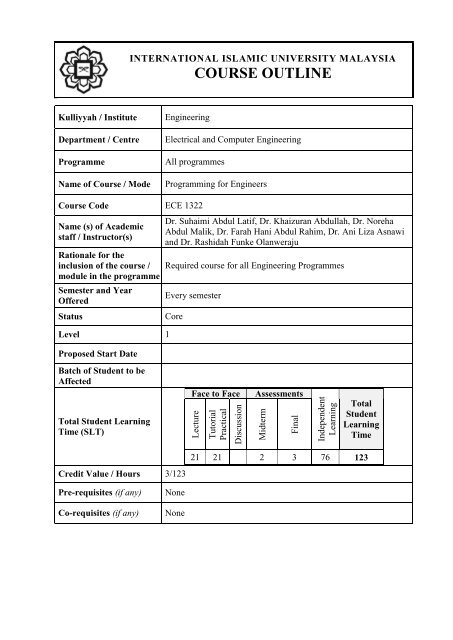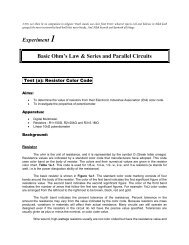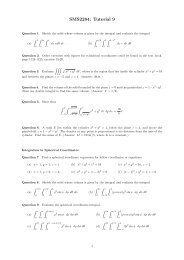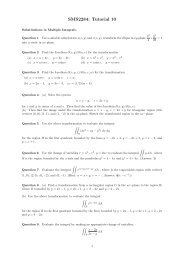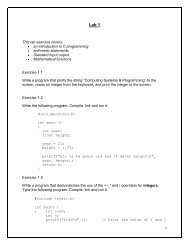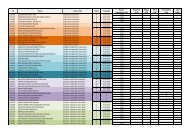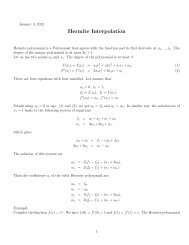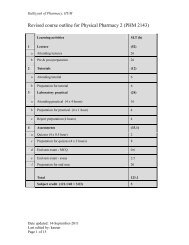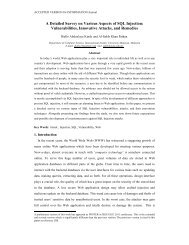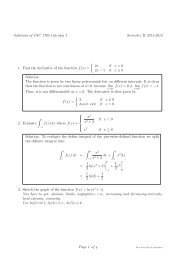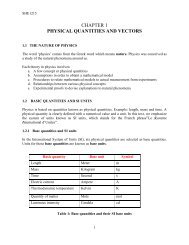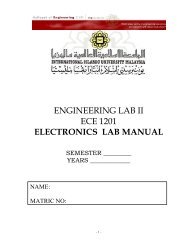Course Outline ECE 1322 - International Islamic University Malaysia ...
Course Outline ECE 1322 - International Islamic University Malaysia ...
Course Outline ECE 1322 - International Islamic University Malaysia ...
Create successful ePaper yourself
Turn your PDF publications into a flip-book with our unique Google optimized e-Paper software.
LectureTutorialPracticalDiscussionMidtermFinalIndependentLearningINTERNATIONAL ISLAMIC UNIVERSITY MALAYSIACOURSE OUTLINEKulliyyah / InstituteDepartment / CentreProgrammeName of <strong>Course</strong> / ModeEngineeringElectrical and Computer EngineeringAll programmesProgramming for Engineers<strong>Course</strong> Code <strong>ECE</strong> <strong>1322</strong>Name (s) of Academicstaff / Instructor(s)Rationale for theinclusion of the course /module in the programmeSemester and YearOfferedStatusLevel 1Proposed Start DateDr. Suhaimi Abdul Latif, Dr. Khaizuran Abdullah, Dr. NorehaAbdul Malik, Dr. Farah Hani Abdul Rahim, Dr. Ani Liza Asnawiand Dr. Rashidah Funke OlanwerajuRequired course for all Engineering ProgrammesEvery semesterCoreBatch of Student to beAffectedTotal Student LearningTime (SLT)Face to FaceAssessmentsTotalStudentLearningTimeCredit Value / Hours 3/12321 21 2 3 76 123Pre-requisites (if any)Co-requisites (if any)NoneNone
<strong>Course</strong> <strong>Outline</strong> <strong>ECE</strong> <strong>1322</strong> 2012/13<strong>Course</strong> ObjectivesLearning OutcomesTransferable Skills:Teaching-Learning andassessment strategy<strong>Course</strong> SynopsisMode of DeliveryThe objectives of this course are:1. To expose students the basic concepts of computing system tosolve a problem in engineering.2. To provide programming skills based on modularity.3. To apply knowledge of mathematics, science and engineeringusing C.4. To develop skills in designing, testing and debuggingprograms.5. To translate the solution into a programme, making use ofconcepts in programming to facilitate the translation process. .6. To introduce the basic operations of the MATLAB language.7. To write simple script files and function files in MATLAB.Upon completion of this course, students should be able to:1. Identify a functional description of the problem includinginput and output specifications, and processing steps to obtainthe output from the input. And develop input/output modulesto read data and write data in a prescribed format.2. Identify appropriate data types (including primitive data types,structures, pointers, and arrays) for storing the input andoutput values.3. Develop and transform a problem into equivalent syntacticallycorrect programming statements, and appropriate controlstructure (if/else, switch, for-loop, while-loop, and/or do whileloop).4. Write code that conforms to a programming style such as usesof user define functions, specified by the instructor, and applybasic testing methodologies and debugging tools to identifyfault points and possible error conditions.5. Use MATLAB in solving simple engineering problems.Skills and how they are developed and assessed:Skills Development AssessmentTechnical Lectures and Programming andLaboratory Written AssessmentAnalytical Project ReportLectures, laboratory, assignments, mini project and quizzesIntroduction to computers as a problem-solving tool using Cprogramming, basic data types, control structures; modularprogramming with functions, array and matrices, pointers andstructures, engineering applications and intro. Introduction toMatlab software.Lectures and Laboratory
<strong>Course</strong> <strong>Outline</strong> <strong>ECE</strong> <strong>1322</strong> 2012/13Assessment Methods andType/<strong>Course</strong> AssessmentState weightage of eachtype of assessment.LO Method %1,2,3,4,5 Quizzes 101,2,3,4,5 Assignments 101,2,3,4 Mini Project 101,2,3,4 Mid-term 301,2,3,4,5 Final Examination 40Mapping of course / module to the Programme Learning OutcomesLearning Outcome of the course1. Identify a functional description of the problemincluding input and output specifications, andprocessing steps to obtain the output from theinput. And develop input/output modules toread data and write data in a prescribed format.2. Identify appropriate data types (includingprimitive data types, structures, pointers, andarrays) for storing the input and output values.3. Develop and transform a problem intoequivalent syntactically correct programmingstatements, and appropriate control structure(if/else, switch, for-loop, while-loop, and/or dowhile loop).4. Write code that conforms to a programmingstyle such as uses of user define functions,specified by the instructor, and apply basictesting methodologies and debugging tools toidentify fault points and possible errorconditions.5. Use MATLAB in solving simple engineeringproblems.Programme Outcomes01 02 03 04 05 06 07 08 09 10 11 12
<strong>Course</strong> <strong>Outline</strong> <strong>ECE</strong> <strong>1322</strong> 2012/13WeeksContent outline of the course / module and the SLT per topicLearningTopicsTask/ReadingHours1(10-14/9)Introduction to Computing Systems and Programming.Variables, Data types, Arithmetic expression.Preprocessor.9Chapters 1, 22(17-21/9)3,4(24/9-5/10)5(8-12/10)C Formatted Input/ Output.Logical operators, control structures, conditionalexpressions, selection statements, loop structures.Modular programming with functions, programmerdefinedfunctions, random numbers.Chapter 9918 Chapter 3, 49 Chapter 56(15-19/10)Arrays, Defining Arrays, Passing Arrays to Functions,Searching and Sorting Arrays, Multiple-subscriptedArrays.9 Chapter 67,8(22/10-2/11)Introduction to pointers, addresses and pointers. PassingArguments to Functions by Reference, PointerExpressions and Pointer Arithmetic. Relationshipbetween Pointers and Arrays. Pointers to Arrays.18 Chapter 79(5/11-9/11)C Character and Strings. Data file processing.9Chapter 8, 1110,11(12-23/11)Introduction to structures, structure definitions,initializing structure, accessing structure members, usingstructures with functions.18 Chapter 1012-14(26/1114/12)Basic introduction to MATLAB language. Commandwindow, Workspace Array manipulations, control-flow,script and function files. Matlab Graphics and Display,Multiple Data sets, Multiple Plots in One Figure. SignalSimulation Model.24 Hands-out
<strong>Course</strong> <strong>Outline</strong> <strong>ECE</strong> <strong>1322</strong> 2012/13Required references supporting the courseP. Deitel, H. Deitel, (2010), C How to Program, 6 th edition, Pearson.Recommended references supporting the courseTan, H.H., D’Orazio, T.B., Or, S.H & Choy, M.M.Y (2012), C Programming: a Q & AApproach, McGraw-Hill Stephen Kochan (2005), Programming in C, 3 rd edition, SAMSH.H. Cheng (2010) C for Engineers and Scientist and Interpretive Approach, Mc-Graw-HillEtter, D.M. & Ingber, J.A., (2005), Engineering Problem Solving with C, 3 rdEdition, Prentice Hall.Etter, D.M., (1995), Engineering Problem Solving with ANSI C: Fundamental Concepts,Prentice Hall.Hanly & Kaufmann, (1996), Problem Solving and Program Design in C, Addison-Wesley.Horton, I., (1997), Beginning C, Wrox Press Ltd.Tan, H.H. & D’Orazio, T.B., (1999), C Programming for Engineering and Computer Science,McGraw-HillStephen J. C., (2007), Matlab Programming for Engineering, 4th ed, Thompson.David C. K., (2004), MATLAB Programming. Pearson Prentice Hall.Prepared by:Checked by:Approved by:Dr. Suhaimi Abd Latif<strong>ECE</strong> <strong>1322</strong> <strong>Course</strong>CoordinatorElectrical and ComputerEngineering DepartmentKulliyyah of EngineeringProfessor Othman O. KhalifaHead of Electrical andComputer EngineeringDepartmentKulliyyah of EngineeringPROF. EMERITUS DATO'WIRA IR. DR. MD. NOOR BINSALLEHDeanKulliyyah of Engineering
<strong>Course</strong> <strong>Outline</strong> <strong>ECE</strong> <strong>1322</strong> 2012/13Programme Learning Outcome (PO): At the end of the programme, Students are able to:Programme Learning Outcome (PO)1. acquire and apply knowledge of mathematics, computers,science, and engineering. (T)2. have in-depth understanding and technical competency inrelevant engineering discipline. (T)3. identify, formulate and provide solutions to engineeringproblems. (T)4. design and conduct experiments, as well as to analyze andinterpret data. (D)5. analyze and design a system, component, or process to achievethe required objectives. (A)6. apply design principles for sustainable development. (D)7. communicate effectively. (S)8. function effectively as an individual and in group with thecapacity to be a leader or manager as well as an effective teammember. (S)9. recognize the need for lifelong learning and to pursueindependent learning for professional development. (S)10. understand the responsibility of a professional engineer in thecontext of contemporary social, cultural, global andenvironmental issues. (ESSE)11. demonstrate understanding and commitment to professionaland ethical responsibilities. (ESSE)12. understand the impact of engineering solutions in a global andsocietal context through broad-based education. (ESSE)MQF DomainKnowledgeKnowledgeKnowledgePractical SkillsProblem Solving andScientific SkillsProblem Solving andScientific SkillsCommunication, Leadershipand Team SkillsManagerial andEntrepreneurial SkillsInformation Managementand Lifelong Learning SkillsSocial skills andResponsibilitiesValue, Attitudes andProfessionalismInformation Managementand Lifelong Learning SkillsThe program learning outcomes (PO) are grouped into 5 general areas to identify the nature ofthe skills and capability involved. These groups are:1. Technical (T) – essential capabilities related to traditional scientific and engineeringknowledge2. Analysis (A) – creatively working with available data and engineering tools and fundamentalknowledge to correctly solve basic problem3. Design (D) – being able to perceive the best solution for both small scale and large scaleproject by involving all required basic problems4. Ethics, Safety, Society and Environment (ESSE) - giving appropriate consideration tomatters pertaining to professionalism and ethics, safety, local and global society and theenvironment5. Work skills (S) – being and effective communicator and effective member of a team and toappreciate the need to continuously acquired skills and abilities.


